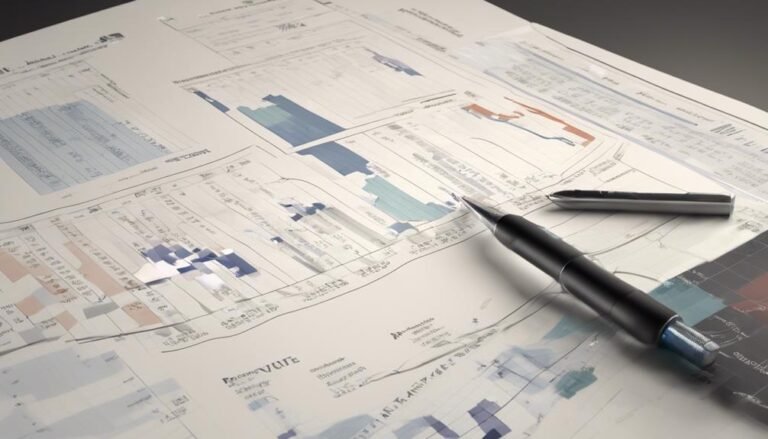Discount Rate Defined: How Its Used by the Fed and in Cash-Flow Analysis
The discount rate, set by the Federal Reserve, influences short-term lending and financial liquidity. In cash-flow analysis, it determines the present value of future cash flows, aiding in investment evaluation and project viability. Key factors impacting discount rate selection include opportunity cost, market conditions, and time horizon. This rate greatly affects investment valuations, with higher rates reducing present value and lower rates enhancing investment attractiveness. Understanding the discount rate is essential for making informed financial decisions and evaluating project feasibility. Its multifaceted role in monetary policy and investment analysis highlights its significance in the financial landscape.
Key Takeaways
- Federal Reserve discount rate regulates short-term lending.
- Discount rate in cash-flow analysis determines present value of future cash flows.
- Influences borrowing behavior among banks and investment decisions.
- Essential for monetary policy decisions and project viability assessment.
- Compares projected cash inflows and outflows, impacting investment valuation.
Federal Reserve Discount Rate Overview
The Federal Reserve discount rate serves as an important tool utilized by the Federal Reserve to regulate short-term lending to commercial banks and financial institutions through its discount window. This rate is a key component of the Federal Reserve's monetary policy toolkit. It is set by the Federal Reserve's Board of Governors and plays a significant role in influencing borrowing behavior among banks.
The discount rate impacts the cost of obtaining short-term funds from the Federal Reserve, affecting overall liquidity levels in the financial system. By adjusting the discount rate, the Federal Reserve can encourage or discourage borrowing, thereby influencing economic activity.
Understanding the Federal Reserve discount rate is essential for comprehending the broader implications of monetary policy decisions on the financial sector and the economy as a whole.
Understanding Discounted Cash Flow Analysis
Within financial analysis methodologies, discounted cash flow analysis plays a pivotal role in evaluating investment opportunities and gauging project viability through the determination of present value based on future cash flows. Investment valuation and capital budgeting heavily rely on discounted cash flow analysis to estimate the value of investments by discounting expected future cash flows.
It aids in decision-making by comparing the projected cash inflows and outflows to assess whether a potential investment or project is financially feasible. By utilizing various discount rates such as the cost of equity, cost of debt, or weighted average cost of capital, businesses can accurately assess the profitability and risks associated with different ventures.
Ultimately, discounted cash flow analysis is a fundamental tool in financial planning and investment decision processes.
Factors Influencing Discount Rate Selection
Factors influencing the selection of an appropriate discount rate for financial analysis include the risk profile of the investment, prevailing market conditions, and the time horizon of the cash flows.
- Opportunity Cost: The discount rate often reflects the opportunity cost of investing in one project over another.
- Investment Valuation: The discount rate directly impacts the valuation of investments, influencing decisions on project viability.
- Market Conditions: Fluctuations in interest rates and market volatility can impact the discount rate selected for analysis.
- Time Horizon: Longer-term projects may require different discount rates compared to short-term investments, considering factors like inflation and uncertainty.
Implications of Discount Rate on Investments
Analyzing the impact of discount rates on investments provides vital insights into the evaluation and decision-making process for financial opportunities. In investment valuation, the discount rate plays an essential role in determining the present value of future cash flows, influencing capital budgeting decisions.
A higher discount rate results in a lower present value of expected cash flows, potentially leading to the rejection of projects with marginal returns. On the other hand, a lower discount rate increases the present value, making investments appear more attractive.
Understanding how the discount rate affects the time value of money is essential for making sound investment decisions, as it directly impacts the profitability and feasibility of projects under consideration.
Practical Applications of Discount Rate
The practical applications of discount rates extend beyond investment valuation to guide financial decision-making and project viability assessments based on present value calculations.
- Investment Valuation: Discount rates are vital in determining the value of potential investments by calculating the present value of expected future cash flows.
- Financial Decision Making: Businesses use discount rates to make informed decisions regarding project feasibility, funding options, and capital allocation.
- Project Viability Assessment: Discount rates help assess the viability of projects by comparing the present value of expected cash inflows with initial investment outflows.
- Risk Assessment: Different discount rates can be applied to account for varying levels of risk associated with projects or investments.
Conclusion
In the intricate tapestry of finance, the discount rate serves as a guiding star, illuminating the path to sound investment decisions and prudent lending practices. Like a steadfast compass, it directs the course of monetary policy and shapes the evaluation of future cash flows.
By understanding the nuances of the discount rate and its multifaceted applications, financial stakeholders can navigate the turbulent waters of the financial landscape with clarity and precision.







